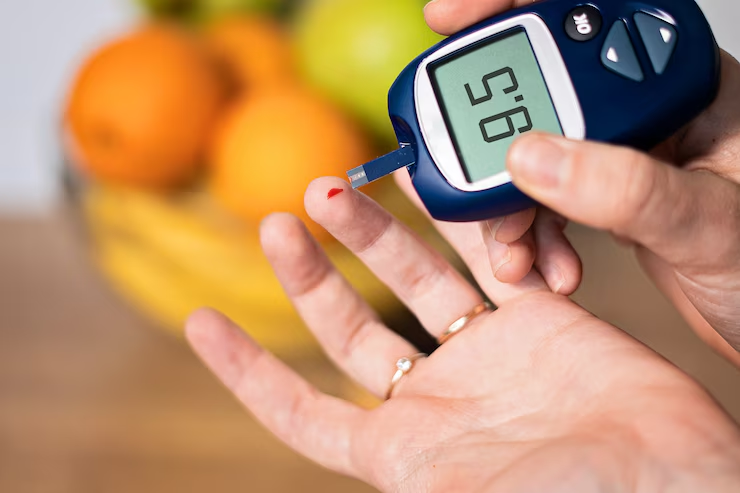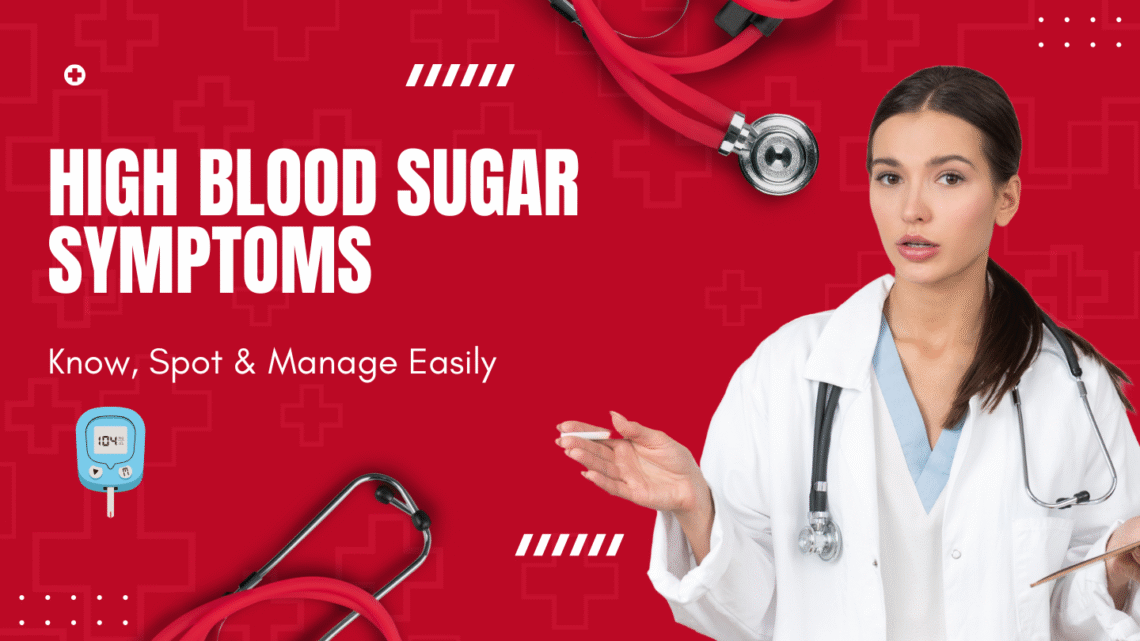In today’s fast-paced world, our eating habits, stress levels, and daily routines can have a major impact on our health. One increasingly common yet often overlooked issue is high blood sugar, also known as hyperglycemia. While many people associate high blood sugar with diabetes alone, anyone can experience occasional spikes, and recognizing the symptoms early is crucial to preventing long-term damage.
This comprehensive guide takes an in-depth look at high blood sugar symptoms, explaining what they mean for your overall health and why they happen in the first place. Recognizing these symptoms early can prevent serious complications and help you take proactive steps toward better health.
Whether you’re currently managing diabetes, at risk of developing it, or simply want to understand how your body works, learning about high blood sugar symptoms is essential. Being aware empowers you to make smarter lifestyle and dietary choices that support balanced glucose levels.
This guide also offers practical, actionable tips for preventing and controlling high blood sugar symptoms, so you can confidently take charge of your health and live a more vibrant, active life.
What is High Blood Sugar (Hyperglycemia)?

High blood sugar, or hyperglycemia, happens when glucose levels in the bloodstream rise above normal ranges. Glucose is the body’s main source of energy, but when it isn’t properly used or regulated, it can build up and cause serious health issues.
In healthy individuals, insulin plays a crucial role in moving glucose from the blood into cells, where it’s used for energy. This process helps maintain balanced blood sugar levels and supports overall body function. When insulin works properly, high blood sugar symptoms are unlikely to occur.
However, when this system becomes disrupted — due to insulin resistance or insufficient insulin production — glucose builds up in the bloodstream. This leads to elevated levels that can trigger high blood sugar symptoms such as fatigue, excessive thirst, and frequent urination.
Additionally, consuming excessive glucose through a high-sugar diet can overwhelm this system. Understanding these factors is key to preventing and managing high blood sugar symptoms effectively.
Normal Blood Sugar Levels
Understanding normal blood sugar levels is key to spotting problems early. In general:
- Fasting blood sugar (before meals): 70–99 mg/dL
- Post-meal (2 hours after eating): less than 140 mg/dL
- Random blood sugar: usually below 140 mg/dL
Persistent levels above these ranges may indicate hyperglycemia and warrant further evaluation.
Why Does High Blood Sugar Occur?
There are several reasons why blood sugar may become elevated:
- Diabetes (Type 1 and Type 2)
- Stress and illness, which trigger hormones that raise blood sugar
- Lack of physical activity
- Excessive carbohydrate intake
- Medication side effects, such as steroids
- Hormonal changes, such as during pregnancy (gestational diabetes)
Regardless of the cause, untreated high blood sugar can lead to serious complications.
The Importance of Recognizing High Blood Sugar Symptoms
Early recognition of high blood sugar symptoms is absolutely vital for protecting your health. Many people dismiss mild signs such as fatigue, increased thirst, or frequent urination, often blaming them on stress, long work hours, or simply being tired. However, these early warnings are your body’s way of signaling that glucose levels may be climbing to unsafe levels. Ignoring these clues can allow blood sugar to remain elevated for extended periods, silently damaging your body.
When high blood sugar symptoms are ignored, glucose can wreak havoc on essential systems throughout the body. Persistently high levels can lead to nerve damage (neuropathy), making your hands and feet feel numb or tingly. Over time, kidneys can become overworked, resulting in chronic kidney disease and even failure. Vision can also be affected, as excess sugar damages the delicate blood vessels in the eyes, leading to diabetic retinopathy and potential blindness.
Additionally, ongoing high blood sugar symptoms significantly raise the risk of cardiovascular issues such as heart disease and stroke. Recognizing and acting on these early signs is crucial for preventing these serious complications. By paying attention to your body and addressing high blood sugar symptoms early, you can take control of your health, protect vital organs, and maintain a more active, fulfilling life.
Common High Blood Sugar Symptoms
1. Frequent Urination

When blood sugar levels are high, the kidneys try to eliminate excess glucose through urine, resulting in more frequent urination. This symptom is often one of the first noticeable signs.
2. Increased Thirst
Due to excessive urination, the body becomes dehydrated, leading to persistent and intense thirst. You may find yourself drinking far more water than usual but still feeling thirsty.
3. Fatigue
High glucose levels can interfere with the body’s ability to use sugar for energy, leaving you feeling constantly tired, sluggish, or weak even after rest.
4. Blurred Vision

High sugar levels can cause fluid to move into or out of the eye’s lens, leading to swelling and temporary blurred vision. If untreated, it can progress to more serious eye problems.
5. Unexplained Weight Loss
In Type 1 diabetes especially, the body starts breaking down fat and muscle for energy when glucose can’t enter cells properly, leading to sudden weight loss despite normal or increased eating.
6. Increased Hunger
Cells deprived of glucose may signal for more food intake, causing constant or intense hunger even after meals.
7. Slow Healing of Cuts and Wounds
High blood sugar affects circulation and immune function, delaying wound healing and increasing infection risk.
8. Recurrent Infections
Frequent skin infections, urinary tract infections, and yeast infections are common signs of elevated glucose levels.
Less Common but Serious Symptoms
- Numbness or tingling in hands and feet (diabetic neuropathy)
- Dry mouth and skin
- Headaches
- Fruity-smelling breath (a sign of diabetic ketoacidosis, a medical emergency)
When to Seek Immediate Medical Help
If you experience extreme thirst, confusion, nausea, vomiting, or abdominal pain along with high blood sugar symptoms, it’s crucial to seek medical attention immediately. These warning signs can indicate a serious condition called diabetic ketoacidosis (DKA) or hyperosmolar hyperglycemic state (HHS), both of which are life-threatening emergencies.
When high blood sugar symptoms progress to this stage, your body is no longer able to manage glucose effectively, leading to dangerous chemical imbalances. Rapid breathing or a fruity smell on your breath are additional red flags.
Recognizing severe high blood sugar symptoms and acting quickly can save your life. Always treat these signs as an urgent medical situation and contact emergency services right away.
Top 8 Tips to Prevent and Manage High Blood Sugar
1. Follow a Balanced, Low-Glycemic Diet
Choose whole grains, legumes, vegetables, fruits, and lean proteins to help prevent high blood sugar symptoms and maintain steady glucose levels. These foods provide essential fiber, vitamins, and minerals that support balanced energy and keep blood sugar spikes in check.

Avoid sugary drinks, which can quickly raise your glucose levels and trigger high blood sugar symptoms like fatigue and excessive thirst. Refined carbohydrates and highly processed foods also contribute to sudden spikes and make it harder to manage your health.
Focusing on whole, nutrient-dense foods supports better long-term control of high blood sugar symptoms. By making these smart dietary choices, you can protect your body, feel more energized, and reduce your risk of complications.
2. Monitor Your Blood Sugar Regularly
Keeping track helps you understand patterns and make informed decisions about food, activity, and medications.
3. Stay Physically Active
Exercise plays a key role in managing and reducing high blood sugar symptoms. When you engage in physical activity, your body becomes more sensitive to insulin, the hormone that helps move glucose from your blood into your cells for energy. This improved insulin sensitivity helps lower blood sugar levels more effectively and can prevent spikes that lead to symptoms like fatigue, frequent urination, or blurred vision.
Regular movement allows your muscles to use more glucose during and after activity, making exercise one of the most effective natural tools for blood sugar control. Whether it’s walking, swimming, cycling, or dancing, moderate activities can help reduce high blood sugar symptoms while improving overall health. Try to aim for at least 30 minutes of activity on most days of the week for the best results.
In addition to helping with high blood sugar symptoms, exercise supports weight loss, boosts energy, and improves mood—all of which contribute to better glucose regulation. Remember to stay hydrated, check your blood sugar before and after workouts if needed, and choose exercises that you enjoy. With consistency, exercise becomes a powerful habit that supports long-term blood sugar control and overall well-being.
4. Maintain a Healthy Weight
Losing even 5–10% of your body weight can make a big difference in managing your health, especially if you’re dealing with high blood sugar symptoms. Carrying excess weight, particularly around the abdomen, can make your body more resistant to insulin, leading to elevated glucose levels. By shedding just a small percentage of your weight, you can improve your body’s ability to use insulin effectively.
When you lose weight, your blood sugar becomes easier to control, which helps reduce or prevent common high blood sugar symptoms like frequent urination, fatigue, blurred vision, and constant thirst. Even moderate weight loss lowers inflammation, reduces stress on your pancreas, and improves your overall energy levels. These changes support long-term health and lower the risk of developing type 2 diabetes or other serious complications.
If you’re experiencing high blood sugar symptoms, taking small, consistent steps toward weight loss—such as eating a healthy diet, staying active, and getting enough sleep—can lead to powerful results. You don’t need extreme diets or intense workouts; simple lifestyle changes can make your blood sugar more manageable and help you feel better every day. Focus on progress, not perfection, and aim for sustainable changes that support your health long term.
5. Stay Hydrated
Water helps flush excess glucose from the blood and prevents dehydration, a common issue in hyperglycemia.
6. Manage Stress
Stress hormones can increase blood sugar levels. Practice mindfulness, meditation, yoga, or other relaxation techniques.
7. Follow Medication Plans
Taking your medication properly is one of the most important steps in managing high blood sugar symptoms. Whether you’re on insulin or oral medications, following your doctor’s instructions exactly as prescribed can help keep your blood sugar within a healthy range. These medicines are designed to help your body process sugar more efficiently and prevent complications.

Never skip a dose, even if you feel okay. Sometimes, high blood sugar symptoms may not be obvious right away, but the damage can still happen silently over time. Missing medication can cause sugar levels to rise quickly, leading to issues like fatigue, increased thirst, frequent urination, and blurred vision. In severe cases, it may lead to dangerous conditions such as diabetic ketoacidosis.
To stay safe and healthy, create a routine for taking your medications. Set reminders or use a pill organizer to ensure consistency. Always talk to your doctor before making any changes to your treatment plan. Proper medication use, combined with a healthy lifestyle, can go a long way in preventing or managing high blood sugar symptoms and improving your overall well-being.
8. Schedule Regular Check-Ups
Routine visits help catch issues early and ensure that your management plan is effective.
Lifestyle Habits to Support Healthy Blood Sugar
- Eat smaller, more frequent meals instead of large, heavy ones.
- Include fiber-rich foods to slow glucose absorption.
- Limit alcohol and quit smoking, both of which impact glucose regulation.
- Get adequate sleep to support hormonal balance and insulin sensitivity.
High Blood Sugar in Non-Diabetics
Not only diabetics experience hyperglycemia; anyone can develop high blood sugar symptoms under certain conditions. Severe stress, for example, can raise hormone levels that spike blood glucose temporarily. Similarly, certain medications, such as steroids, can disrupt glucose regulation and lead to unexpected high blood sugar symptoms.
Infections and hormonal imbalances also play a role by interfering with insulin function or increasing glucose production in the body. These temporary spikes are often overlooked but still need attention to prevent complications.
Addressing the underlying cause and making key lifestyle changes—like improving diet, staying active, and managing stress—can help restore healthy levels and reduce high blood sugar symptoms, even in non-diabetics.
Long-Term Risks of Untreated High Blood Sugar
Ignoring high blood sugar symptoms can lead to:
- Cardiovascular disease
- Kidney damage
- Vision loss (diabetic retinopathy)
- Nerve damage (neuropathy)
- Poor wound healing and amputations
- Increased risk of infections
- Cognitive decline
How Family and Friends Can Help
Social support plays a critical role in managing high blood sugar. Loved ones can help by:
- Encouraging healthy eating and exercise habits
- Attending doctor appointments for support
- Helping monitor symptoms and blood sugar levels
- Providing emotional encouragement
The Role of Healthcare Professionals
Your healthcare team — including doctors, dietitians, diabetes educators, and nurses — plays a vital role in managing high blood sugar symptoms. They can help create a personalized plan tailored to your unique needs, ensuring you maintain healthy glucose levels and prevent complications.
Open communication with your healthcare team is essential. Discussing any changes or new high blood sugar symptoms allows them to adjust your treatment plan quickly and effectively. Regular lab tests also help track your progress and catch potential issues early.
Ongoing education is equally important for long-term success. By learning about nutrition, medication, and lifestyle strategies, you can take control of high blood sugar symptoms and protect your health for years to come.
Myths About High Blood Sugar
- “Only diabetics need to worry about high blood sugar.”
False — anyone can experience it. - “Cutting out all carbs is the solution.”
False — your body needs healthy carbs; focus on quality and portion control. - “Feeling fine means your sugar levels are fine.”
False — you can have dangerously high blood sugar without immediate symptoms.
Looking Ahead: Advances in Blood Sugar Management
New technologies like continuous glucose monitors (CGMs) and smart insulin pumps are transforming how we manage high blood sugar symptoms. These advanced tools allow for real-time tracking of glucose levels, making it easier to catch spikes before they become dangerous. With CGMs, you can see trends and make quick adjustments to diet, activity, or medication.
Smart insulin pumps deliver precise doses, helping maintain stable levels and reducing the risk of sudden high blood sugar symptoms. These innovations offer more freedom and control for those living with diabetes.
Research into personalized medicine and digital health tools continues to advance, promising even better solutions for managing and preventing high blood sugar symptoms in the future
Conclusion: Listen to Your Body
High blood sugar can often be silent but extremely dangerous. Many people don’t notice high blood sugar symptoms until complications arise, making early awareness critical. Recognizing signs like excessive thirst, fatigue, or frequent urination helps you act quickly and avoid serious health issues.
By adopting healthy lifestyle habits — including a balanced diet, regular exercise, and stress management — you can better control high blood sugar symptoms and support overall wellness. These daily choices play a major role in maintaining stable glucose levels.
Working closely with your healthcare team ensures personalized guidance and ongoing support. By staying proactive and informed about high blood sugar symptoms, you can enjoy a more energetic, active, and fulfilling life.
.
Final Thought
Start today — even small, simple changes can greatly impact your blood sugar levels and reduce high blood sugar symptoms. Adding a daily walk to your routine helps improve insulin sensitivity and supports overall glucose control. Regular physical activity is one of the most effective ways to prevent spikes and manage energy levels.
Choosing water over soda is another easy but powerful step. Sugary drinks can cause sudden increases in glucose, worsening high blood sugar symptoms and adding unnecessary calories. Staying hydrated with water supports better metabolism and kidney function.
By making these small, consistent changes, you’ll build healthier habits that help prevent high blood sugar symptoms and improve your overall health and well-being.





